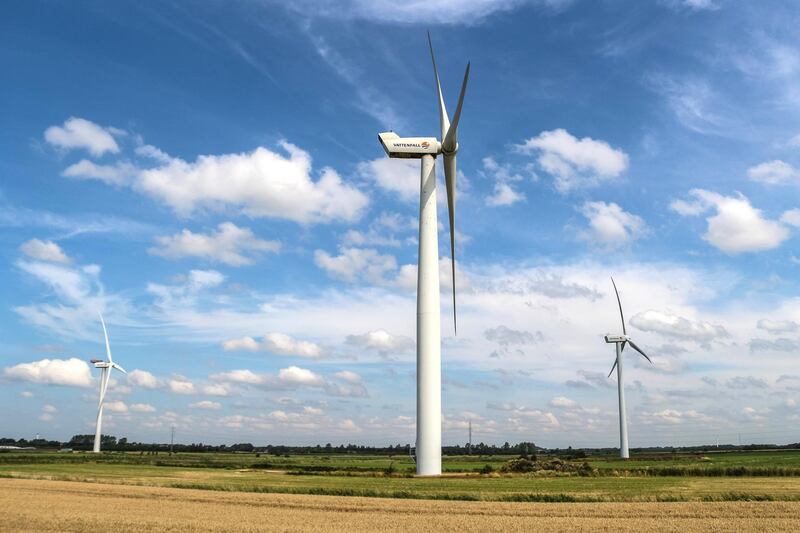Politics, personalities, profits and pandemics may be the memorable events of the year just gone. But with Apple, Microsoft, Google, Facebook and Tesla dominating the stock market, it is technology that defines the expanding space of possibility. And that applies even more to the sector at the centre of geopolitics and the global environment: energy.
The most important technology for energy in 2021 is not even from that field. The astonishing success in fielding three widely-approved vaccines for Covid-19 within a year, with more on the way, promises an end to the outbreak. There are logistical and organisational hurdles, question marks surrounding its effectiveness, and worries about how well these vaccines will protect against a new, more infectious strain. But gradually this year, the world should get on top of the coronavirus. And that allows businesses fully to reopen, flights to resume, bringing more oil consumption - at least in the short term.
We have all become too familiar with Zoom. But this, and other home and remote working software, will be crucial in determining how much and how fast transport demand and oil use bounce back. Still frustratingly filled with glitches, they do not easily replace in-person networking and collaboration. Nevertheless, working from home at least a few days a week, and cutting out much long-distance travel to business meetings and conferences, will likely become the norm.
E-learning has gone further than the rather traditional and unimaginative use of videoconferencing by many businesses. If more flexible tools for collaboration are widely adopted, and ways of working adapt accordingly, that will downsize city-centre offices and cut road, public transport and air fuel use. On the other hand, a trend to move to bigger suburban and rural homes will require more heating, cooling and lighting with gas and electricity.
Renewable electricity is booming, with record low prices for solar in the GCC and offshore wind in north-west Europe. GE and Siemens have both launched wind turbines almost the height of the Empire State Building that put out 14 megawatts each. Ingenious work on superconductors, permanent magnet drives, lightweight materials and giant offshore installation vessels could take this up to 20 MW and beyond.
Solar photovoltaic cells too have room for further improvement. Instead of the usual silicon, a set of materials known as perovskites promise almost twice the efficiency, and are easier to manufacture. They have been much-touted for some years, but struggled to overcome concerns about limited lifespan and toxicity. British firm Oxford PV wants to make them commercially available for the first time this year.
Stabilising a renewable-powered electricity grid and building cheaper, longer-range electric vehicles both rely on better batteries. Many promising designs have proved to be impractical or over-hyped. But there is growing excitement that a workable solid-state lithium-ion battery may be on its way. This would have almost twice the energy density of current liquid electrolyte batteries, be non-flammable, charge within fifteen minutes and have a longer life.
California-based QuantumScape, backed by VW and Bill Gates, and Toyota, both report promising results on their solid-state designs, hoping they could be in commercial vehicles by mid-decade. If they are right, BP’s prediction that 2019 was the all-time peak for oil demand may be borne out as electric cars surpass their petrol and diesel forebears in affordability and performance.
Self-driving cars have advanced more slowly than expected a few years ago, as the practical and safety challenges became clear. But, within limited areas in China and the US, they are starting trial commercial operations. Their synergies with battery power will help advance both, drastically upending traditional motor manufacturers, transport firms, road design and perhaps the whole model of private car ownership. But they will also likely encourage a boom in long-distance travel.
Hydrogen has gone through at least two major cycles of hype in the 1970s and early 2000s. Now it is back, hopefully with more realism. A clean and versatile energy carrier that produces only water when burnt, it and its derivatives could fuel ships, planes and power plants, heat homes and forge steel.
The basic production technologies are well-established, but 2021 is a key year to see progress on large-scale projects, such as the renewable-powered facilities planned at Neom in Saudi Arabia and Duqm in Oman. In turn, that should bring down the cost of the electrolysers that split water to make hydrogen, and we will begin to understand how soon it can be commercially viable.
Hydrogen today is nearly all made from fossil fuels, with carbon dioxide emissions. The Allam Cycle, a new type of compact, highly efficient gas turbine, generates electricity while capturing all of its carbon dioxide. A pilot plant is working in Texas, and NET Power, the developer, had been hoping for first commercial generation next year. It can be adapted to produce hydrogen from gas or coal, cheaply and cleanly. Flexible, affordable carbon capture and hydrogen are the missing pieces alongside renewables for a comprehensive zero-emissions economy.
These technologies may not all break through in 2021. Practical and commercial viability is a long way from promising lab results and pilots. Social systems, people’s habits, laws, regulations and urban layouts, have to adapt to make the most of really transformative technologies.
But even a few successes will radically change the energy world. It is promising to see the importance that entities such as Mubadala, ADQ and ADIO give to tech and energy investments. The region and private-sector investors need to go much further in leading an energy revolution, building on oil and gas expertise before that is left behind by advances elsewhere.
Robin M. Mills is CEO of Qamar Energy, and author of The Myth of the Oil Crisis






